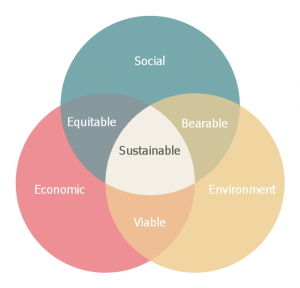Sustainability Individual Report
The ideology of sustainability focuses satisfying present needs without sabotaging the future generations’ ability to satisfy their needs. The concept of sustainability consists of three essential factors: economic, environmental and social. In order to achieve sustainability, we must take into consideration the impact of all three factors.
Your ecological footprint is the amount of impact you had on the environment through your lifestyle, and your consumption of goods. For example, a t shirt uses at least 150 litres of water during its production, that means when you purchase it, you have imposed a burden of 150 litres of water consumption upon the environment. The water used can not be used for drinking or production in other industries thus being not renewable. With a global population of almost 7 billion, it is important that we recognise our individual, and total environment impact so that our consumption does not exceed the amount of resources that be produced sustainability. Else the Earth’s resources will dry up in the near future, and children may have to live in harsh conditions unfit for human survival.
Above is my personal ecological footprint, and my largest output is carbon output, which takes up about 55% of the total footprint. Two biggest contributors to my carbon footprint are my foods ,and services consumption. However, through reflecting upon my lifestyle, I reckon that the second biggest output would be my electricity usage as I turn on air-conditioning as soon as I get home, and I use a large variety of electricity consuming products.As for my food consumption, I eat a large variety of food that consists of different kinds of meat and spices which contributes quitely heavily to the footprint.
Before doing in depth research for this project, I had not realised how much impact the production of foods make on the environment. Beef and dairy related products creates many greenhouse emission. These products come from cows, and cows feed on grasslands. These farm animals require huge amounts of space, and in need of grasslands, many farmers choose to cut down forests for the nutritious soil in the land. Deforestation causes the soil to become less firm, and speeds up erosion. Carbon dioxide is also process and converted into oxygen at a slower rate as a result of this. Losing forests can also lead to loss of habitats for many animals. Farm animals like pig and cows respire, then breathe out large amounts of carbon dioxide as well as farting methane gas, both of which are greenhouse gases that encourage global warming. A lot of water is also consumed when raising the animals, imposing a heavy burden upon the Earth’s already scarce water resource.
Electricity can be generated through many methods likes burning coal, nuclear fission, and harnessing wind energy. However, it is still primarily generated through unsustainable combustion of non-renewable resources and nuclear fission. Burning of coal and oil produces greenhouse gases like carbon dioxide and nitrogen oxides. Nuclear fission is very dangerous, and waste disposal has potential to be hazardous to both humans and the environment. Storage of radioactive materials require much maintenance, yet still being damaging to the soil and water bodies surrounding it.
I would start working on eating less meat, or buying food that is unpackaged and locally sourced. Through eating less meat, I am reducing deforestation and carbon output by a small portion. Buying unpackaged food helps reduce plastic use, and buying food produced in nearby regions reduce fuel use during transport. I should also starting turning air-conditioning on less frequently, and turn off electric appliances when I am not using them. I should take shorter showers, and hopefully cold showers so that there is less water usage, and less burning of non-renewable fuel for heating. I should start adding my food waste to composts so we can use them to plant more greenery that would produce oxygen while absorbing carbon dioxide.
If I were to choose one of these changes, I would choose to eat a lot less beef and dairy products. The impact of deforestation is so severe, and almost irreversible at the rate we are doing it. The environmental cost of raising cattles are heavy in many aspects like greenhouse gas emissions, soil erosion, destruction of biomes, etc. By eating less beef related products, I am able to make change on many front, maximising my impact.
Works Cited
“Sustainable Development | Path to Sustainable Development | Venn Diagram Examples for Problem Solving. Environmental Social Science. Human Sustainability Confluence | Sustainable Development Diagram.” Https://Www.conceptdraw.com, www.conceptdraw.com/examples/sustainable-development-diagram.


hag@gapps.uwcsea.edu.sg
Sustainability your definition of sustainability is precise and includes the key ideas that underpin this idea. It would have been good to explain the Venn diagram that you have referenced to provide a little more detail.
My Ecological Footprint – You have used data in a clear way to explain the concept of ecological footprint and the T-shirt example was a good one to illustrate your point. You have analyzed your results well and considered the variables within this. You have applied your understanding of the science behind these ideas well and made a good link between food and travel with greenhouse emissions. Perhaps this could be reinforced with more data to support.
Making changes – Your changes are totally appropriate give the conclusions from your ecological footprint results and clearly connect it to big environmental issues
Communication – You have used technical language in a clear and informative way. You have used data to support your thinking although you could look to expand this in the future to higher level scientific concepts